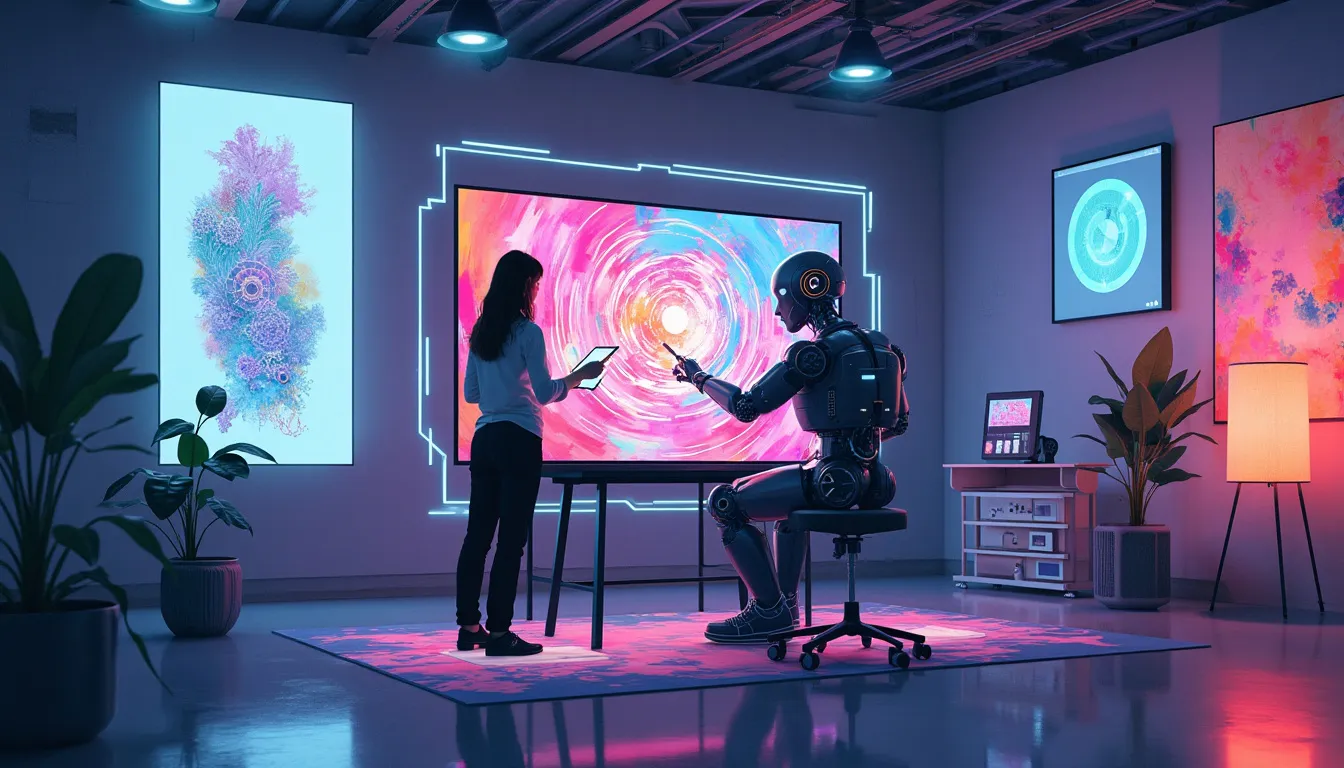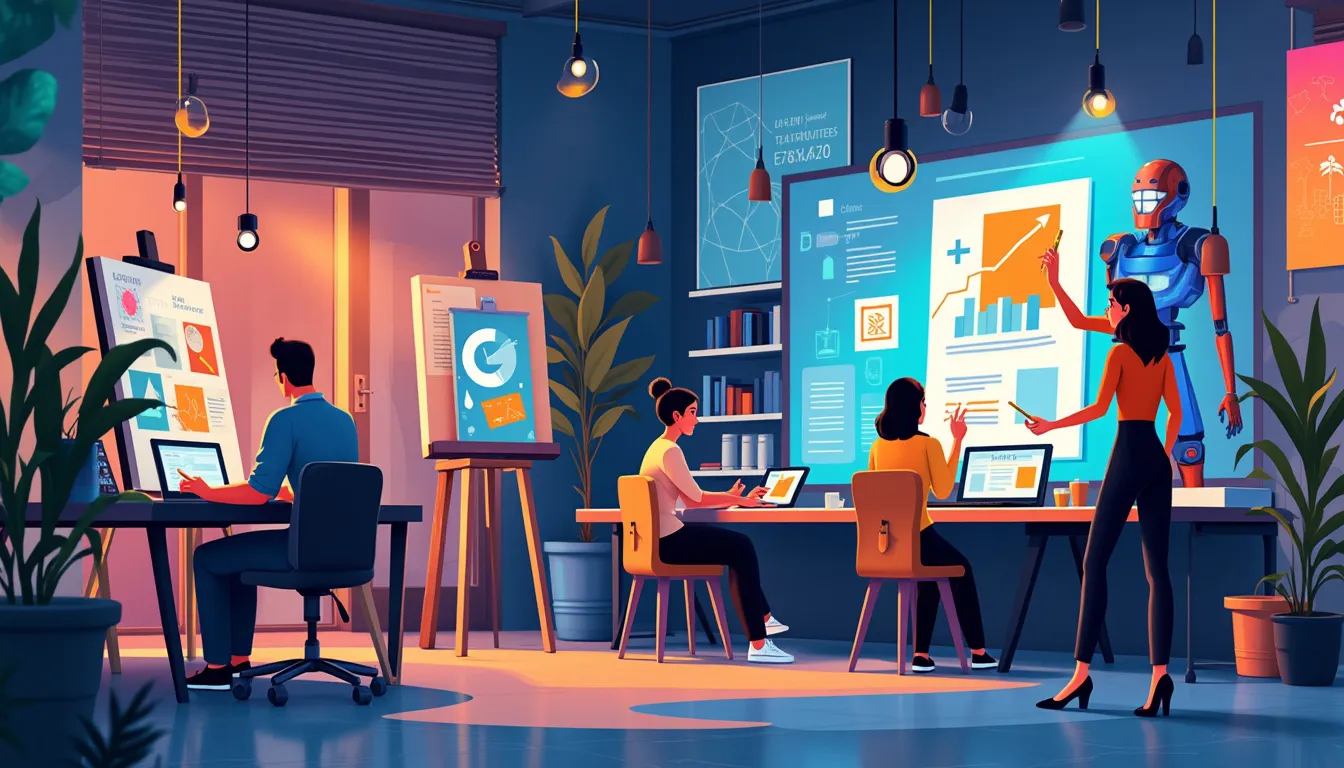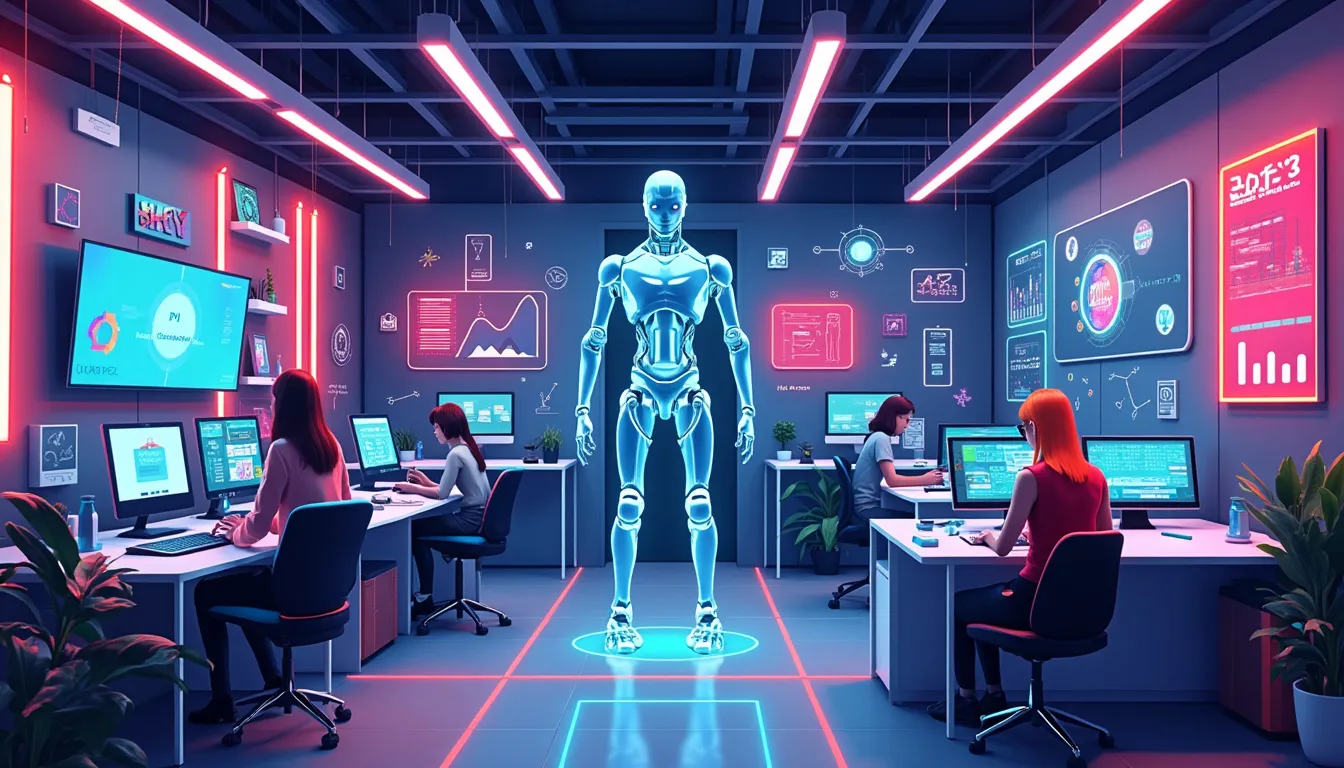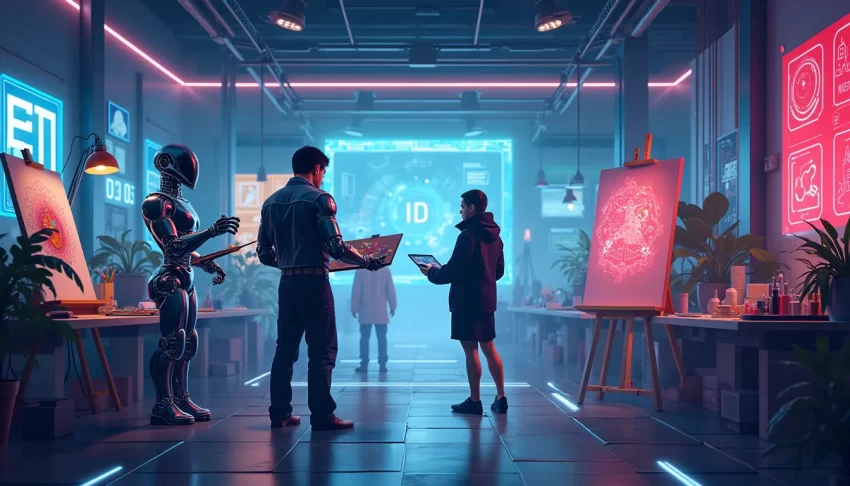Artificial Intelligence (AI) has transcended its traditional boundaries, rapidly emerging as a disruptive force in the creative industries. From transforming mundane tasks into intricate designs, to crafting personalized musical compositions, the future of AI in creative industries is not just promising; it is revolutionary. Currently, AI plays a supportive yet significant role in creative fields, aiding artists, designers, and creators in pushing the boundaries of innovation. This burgeoning relevance of AI underscores its potential to reshape how creativity and innovation interact. Over the years, AI has evolved from basic algorithmic tools to sophisticated systems capable of producing stunning art, composing symphonies, and even generating compelling narratives. The impact of this evolution is profound, heralding a new era where creativity is not confined to human minds alone but is a harmonious interplay between human ingenuity and machine intelligence. Join us as we explore how AI is transforming digital art, enhancing audio production, revolutionizing film and video creation, and redefining writing and content development, while also navigating the benefits, challenges, and future trends poised to redefine the creative landscape.
The Future of AI in Creative Industries
Overview of AI’s Current Role in Creative Fields
Artificial Intelligence (AI) has transitioned from a mere technological novelty to an indispensable tool across various sectors, including the creative industries. Today, AI influences everything from graphic design and music composition to film production and creative writing. Its presence not only enhances the creative process but also introduces new paradigms and possibilities that were previously unimaginable. For instance, AI-driven programs like Adobe’s Sensei and OpenAI’s DALL-E have already become integral in generating visually stunning artworks and practical design solutions, pushing the boundaries of what human creativity can achieve with machine assistance.
Importance & Relevance of AI in Today’s Creative Industries
In today’s hyper-competitive and rapidly evolving creative landscape, staying ahead of the curve is paramount. Here, the significance and relevance of AI come to the forefront. AI’s ability to analyze vast amounts of data swiftly enables creatives to gain insights and fine-tune their works to better align with audience preferences. For example, music streaming services like Spotify utilize AI to recommend personalized playlists, thereby enhancing the user experience and ensuring that artists connect with their optimal audience. The relevance of AI is not restricted to efficiency; it fosters innovation by providing creators with novel tools and techniques to experiment and develop new forms of artistic expression.
The Evolution of AI and Its Potential Impact
The evolution of AI over the past decade has been nothing short of revolutionary. Initially limited to automating rudimentary tasks, AI has now evolved to understand and emulate complex human behaviors and patterns. Its potential impact on creative industries is multifaceted and profound. For example, AI algorithms can now generate original artworks based on a set of parameters or even create music compositions that evoke specific emotions. Moreover, AI tools like IBM’s Watson have demonstrated the ability to edit and refine film scripts, enhancing narrative coherence and character development.
One inspiring story comes from a digital artist who uses AI as a creative partner. Struggling with ADHD and OCD, the artist found solace in leveraging AI tools to organize and streamline their creative process. This not only boosted productivity but also offered a therapeutic element, allowing the artist to focus on ideation and execution without being overwhelmed by the minute details. Such anecdotes illustrate the human-AI collaboration’s potential to overcome personal challenges and enhance overall creative output.
Real-World Examples and Case Studies
Consider the fashion industry, which is increasingly leveraging AI to predict trends and design clothing lines. Companies like H&M and Zara utilize AI-driven analytics to interpret market behaviors and consumer preferences, streamlining their design and production processes. In film, AI-powered tools are employed to enhance special effects and even generate realistic human characters through sophisticated CGI techniques.
Moreover, the gaming industry showcases AI’s dynamic role in creating immersive environments and responsive non-player characters (NPCs). AI enables game developers to produce more engaging and personalized gaming experiences, attracting a broader audience and elevating the entire entertainment medium. These instances highlight how AI is not merely an auxiliary component but has become a pivotal element driving innovation and efficiency in creative industries.
The Path Forward
The future of AI in creative industries heralds a transformative era, where the synergy between human creativity and machine intelligence sets the stage for unparalleled advancement. As AI continues to evolve, its integration into creative workflows will become increasingly seamless, empowering creators to transcend traditional limitations. To harness this potential, it is crucial for industry professionals to remain adaptable and open to learning, embracing AI as an ally rather than a competitor.
In summary, the role of AI in creative fields is no longer speculative; it is a tangible reality that is reshaping how we conceive, create, and consume art. By understanding AI’s current contributions, acknowledging its importance, and anticipating its future impact, we can better prepare for an era where creativity and technology converge harmoniously.

Transformative Applications of AI in Creative Industries
AI in Digital Art and Design: Creating New Possibilities
Artificial Intelligence is profoundly reshaping digital art and design. Traditionally manual processes are being complemented and sometimes wholly transformed by AI-powered tools, which offer creators an expansive palette of new possibilities. Let’s consider the example of algorithm-driven art. AI algorithms, like Neural Networks, can analyze and emulate artistic styles, enabling creations that blend human ingenuity with machine precision. An illustrative example is Google’s DeepDream, which can generate hallucinogenic, dream-like images from existing photographs, pushing the boundaries of human creativity.
Through these tools, artists are no longer confined by their technical skills. Instead, they can focus more on conceptual and emotional aspects of their work, while AI handles the sophisticated coding and technicalities. This collaboration has democratized art creation, offering almost anyone the ability to produce visually stunning work without years of traditional training.
Enhancing Music and Audio Production with AI Tools
The music industry, always a hotbed for innovation, is also experiencing an AI-driven renaissance. AI tools are being used from composition and production to mastering and distribution. Take, for instance, applications like OpenAI’s MuseNet, which can compose music in various styles, ranging from classical to contemporary pop, based on a data-driven understanding of music theory and genre-specific patterns.
Producers and musicians are leveraging AI to experiment with new sounds, streamline their workflow, and even resurrect the voices of iconic artists for modern compositions. Additionally, AI-driven mastering services like LANDR use machine learning algorithms to optimize audio quality, making professional-grade mastering accessible to independent artists on a budget.
The implication here is profound; musicians are now empowered to iterate rapidly, break new ground in genre and style, and even collaborate with AI as a co-creative force.
AI-driven Innovations in Film and Video Production
Film and video production are arenas where AI’s transformative power is particularly evident. Filmmaking, traditionally a resource-intensive process, benefits immensely from AI through enhanced visual effects, streamlined editing, and predictive analytics in pre-production stages.
Consider visual effects: AI can automate several aspects of special effects creation, making it quicker and more cost-effective. Tools like Adobe’s After Effects are integrating AI features to assist in tasks such as rotoscoping and color grading, which were previously labor-intensive. Moreover, AI algorithms can analyze huge volumes of footage to tag and catalog scenes, significantly easing the burden on editors and allowing for more focus on creative decision-making.
In screenwriting, AI tools like Scriptbook can evaluate scripts for elements like market viability and potential box office success, giving producers critical insights before they commit significant resources. This ability to predict audience reactions and optimize content accordingly helps streamline the production process and potentially increases the likelihood of commercial success.
The Role of AI in Writing and Content Creation
Writing and content creation have seen a remarkable influx of AI tools that aid in drafting, editing, and even conceptualizing new content. For instance, GPT-3 by OpenAI is revolutionizing how writers approach their craft. This language model can generate coherent and contextually relevant text, often indistinguishable from human writing.
Take the case of an overwhelmed writer facing a tight deadline. By leveraging an AI-driven tool like GPT-3, the writer can quickly generate drafts, overcome writer’s block, and iterate ideas faster than ever. This newfound efficiency doesn’t just alleviate the pressure but also opens up time for more strategic and creative endeavors.
Furthermore, AI can assist in content personalization. Platforms like Persado use AI to craft personalized marketing messages that resonate with different audience segments based on data analytics. This fusion of creativity and data ensures that content is not only engaging but also strategically targeted.
AI’s role extends beyond just generating text. Tools like Grammarly use sophisticated algorithms to enhance the quality of writing, catching grammatical errors, suggesting stylistic improvements, and even providing insights on tone and clarity. These applications empower writers to refine their work to perfection, minimizing the mundane aspects of editing.
In harnessing the future of AI in creative industries, it’s clear that these transformative applications are not just enhancing existing processes but also creating new paradigms of creativity. As we continue exploring these innovations, it’s crucial to approach this confluence of technology and creativity with an open mind, ready to seize the opportunities while navigating the challenges it presents.

Benefits and Challenges of AI Integration
Efficiency and Productivity Gains in Creative Processes
One of the most significant benefits of integrating AI in creative industries is the enhancement of efficiency and productivity. Through sophisticated algorithms, AI can automate repetitive tasks, allowing creative professionals to focus on more complex and innovative aspects of their work. For instance, in digital art and design, AI-powered tools can streamline the creation process by automatically generating layout suggestions or even entire pieces based on certain parameters set by the artist. This not only saves time but also opens up new avenues for experimentation and creativity, fostering a more dynamic and productive environment.
Consider the example of a graphic designer working on a marketing campaign. Traditionally, the designer would need to manually manipulate images, adjust layouts, and perform a plethora of tweaks to achieve the desired outcome. With AI tools, however, many of these tasks can be automated, with the AI suggesting multiple design iterations based on the initial input. This allows the designer to select the most promising options quickly, significantly speeding up the creative process.
Personalization and Customization of Creative Outputs
The future of AI in creative industries promises a high level of personalization and customization in creative outputs. AI algorithms can analyze vast amounts of data, including user preferences and behavior, to tailor content that resonates on an individual level. This capability is particularly advantageous in fields such as marketing, content creation, and media production, where understanding the audience is crucial.
For example, AI can be used in advertising to create highly personalized ad campaigns. By leveraging user data, AI can craft messages and visuals that are more likely to engage specific demographics. Similarly, in the music industry, AI can curate playlists that cater to the unique tastes of each listener, enhancing the overall user experience. These personalized experiences not only increase customer satisfaction but also drive higher engagement and loyalty.
Addressing Ethical Concerns and Creative Authenticity
While the benefits of AI integration are compelling, it is essential to address the ethical concerns and questions about creative authenticity that arise. One such concern is the originality of AI-generated content. Can a piece of art or a musical composition created by an AI be considered truly original, or is it merely a sophisticated amalgamation of existing works? This debate touches on the core values of creativity and originality, necessitating a robust ethical framework to guide AI’s application in creative industries.
Moreover, there is the concern of job displacement as AI tools become more prevalent. While AI can significantly boost productivity, there is a realistic fear that it may render some roles obsolete. Creative professionals may worry about their place in an industry increasingly dominated by intelligent machines. It is crucial for stakeholders to consider how AI can complement rather than replace human creativity, ensuring that the integration of AI does not diminish the human touch that is so vital to creative expression.
One way to address these ethical concerns is through transparent collaboration between AI and human creators. Developing clear guidelines on the use of AI, acknowledging the contributions of human artists alongside AI-generated content, and ensuring that AI tools are used to augment rather than replace human creativity can help maintain ethical standards in the industry.
Overcoming Technical and Adoption Barriers
Integrating AI into creative processes is not without its challenges. Technical barriers such as the need for significant computational power, data quality issues, and the complexity of developing and maintaining AI systems can pose significant hurdles. For smaller creative enterprises and individual artists, the cost and technical expertise required to implement AI solutions can be prohibitive.
Moreover, there is often a resistance to adopting new technologies, stemming from a lack of understanding or fear of the unknown. Creative professionals may worry that relying on AI tools could stifle their original ideas or disrupt their established workflows. To overcome these barriers, it is crucial to provide adequate education and training on the benefits and functionalities of AI. By demonstrating the practical advantages and fostering a culture of curiosity and open-mindedness, industry leaders can help ease the transition towards AI integration.
A practical approach could involve phased implementation, starting with simple AI tools that automate basic tasks and gradually introducing more complex systems as confidence and familiarity grow. Encouraging a collaborative ecosystem where AI developers and creative professionals work closely together to tailor AI tools to specific needs can also facilitate smoother adoption and more meaningful integration.
In summary, while there are certainly challenges to integrating AI into creative industries, the potential benefits are substantial. As we navigate this transformative journey, addressing ethical concerns, overcoming technical barriers, and fostering a culture of collaboration and continuous learning will be key to harnessing the full potential of AI for creative innovation.

Future Prospects and Trends
Emerging AI Technologies Shaping Creative Industries
As we look ahead, the future of AI in creative industries holds exciting prospects characterized by rapid advances in AI technologies. Generative Adversarial Networks (GANs), for instance, are revolutionizing digital art by enabling the creation of highly sophisticated, unique pieces. GANs function through a collaborative mechanism where two neural networks—the generator and the discriminator—compete, thereby refining the creativity output. Imagine an artist never running out of inspiration because their AI counterpart continuously generates novel ideas.
Similarly, Natural Language Processing (NLP) technologies are pushing the envelope in content creation. NLP’s ability to understand and generate human language allows for the development of AI writers that can draft articles, scripts, or even poetry. Leading examples include OpenAI’s GPT-3, which is already demonstrating remarkable capabilities in generating human-like text. However, as someone who has navigated attention-related challenges such as ADHD, I see the immense potential of such technology in helping streamline and focus creative processes that might otherwise become overwhelming.
Collaborative AI-Human Efforts: Harmonizing Creativity
The future doesn’t spell the replacement of human creators but rather a new era of collaboration. AI and human partnership can harmonize creativity, leveraging the strengths of both aspects. This symbiosis is seen in modern video game design, where AI algorithms handle environmental details, freeing creators to focus on storytelling and character development. Moreover, AI can act as a co-pilot in creative endeavors, akin to an orchestrator in a symphony, finely tuning each section to benefit the whole.
A compelling story from my experience managing ADHD and OCD illustrates this point. The cognitive load of these conditions can sometimes make it hard to stay organized and maintain momentum. I’ve found that AI-driven project management tools significantly alleviate these pressures by automating repetitive tasks and flagging priorities. Thus, AI enables a focus on high-level creative tasks, allowing human ingenuity to flourish.
Predictions and Future Scenarios: What Lies Ahead
The horizon brims with possibilities, driven by continuous advancements in AI. In the future, we might see more augmented reality (AR) and virtual reality (VR) applications powered by AI, transforming how we consume and create content. These immersive experiences could redefine storytelling, making narratives more interactive and engaging.
Moreover, AI could deepen personalization in media consumption. Imagine streaming services that not just recommend but curate bespoke content, crafted to fit individual tastes and emotional states, down to the most nuanced preferences. Think of it as having a personal curator, who understands and anticipates your next binge-worthy series or movie, which would be a godsend for individuals grappling with choice paralysis often related to ADHD.
Final Thoughts on Embracing AI for Creative Evolution
It’s clear that the future of AI in creative industries isn’t a question of ‘if’ but ‘how’. The creative landscape is set for a transformative evolution, with AI acting as a powerful catalyst for innovation. Balancing AI-driven efficiencies with human creativity will be essential. Producers, artists, and creators should seek to understand and embrace these technologies proactively.
A piece of actionable advice: Start small but think big. Integrate AI tools gradually into your creative processes, observing their impact on efficiency and output. And for those managing personal challenges like ADHD, OCD, or weight loss journeys, don’t shy away from leveraging AI as an aid. The goal should be to make technology work for you, enhancing your unique capabilities and storytelling prowess. With a balanced approach, AI can be more than just a tool—it can be a co-creator in your journey toward revolutionary creativity.
As we look towards the future of AI in creative industries, it’s evident that we’re standing at the precipice of a revolution that promises to reshape the landscape of creativity and innovation profoundly. The transformative power of AI is already being felt across digital art, music production, film, and content creation, bringing forth new avenues for artistic expression and efficiency that were once the stuff of science fiction.
The key takeaway from this exploration is that AI’s role is not simply about replacing human creativity but augmenting it. In the realm of digital art and design, AI is breaking new ground, creating designs and artworks that push the boundaries of imagination. For instance, tools like DeepArt and Adobe’s Sensei are assisting artists in generating visually stunning pieces by learning from a vast array of artistic styles and techniques. Similarly, AI’s contribution to music and audio production can be seen through platforms like Amper Music, which allow musicians to compose entirely new pieces by leveraging AI’s capabilities to understand and generate complex compositions.
The film and video production industry also benefits significantly from AI, with innovations such as deep learning algorithms enhancing special effects and automating complex editing tasks, thereby expanding the possibilities for filmmakers. Meanwhile, AI’s role in writing and content creation has seen it emerge as a key player in generating engaging narratives, news articles, and marketing content, often with a level of customization and personalization that caters specifically to audience preferences.
However, integrating AI into creative workflows is not without its challenges. Ethical concerns and questions of authenticity arise when machines begin to contribute significantly to creative processes. Additionally, there’s the inevitable resistance to change and the technical hurdles that come with adopting advanced AI systems. Yet, the potential benefits—greater efficiency, the ability to personalize creative outputs, and the opening up of new creative frontiers—make these hurdles worth overcoming.
Looking ahead, the prospects for AI in creative industries are both exciting and daunting. Emerging technologies such as GANs (Generative Adversarial Networks) and advanced neural networks promise to further blur the lines between human and machine creativity. The future likely holds a more harmonious blend of AI-human collaborations, where AI assists in the ideation and execution of creative projects while humans retain their unique touch of intuition and emotional depth.
In conclusion, the future of AI in creative industries is a landscape rich with potential, ripe for those ready to embrace the evolution of creativity. By leveraging the strengths of AI, creatives can not only enhance their productivity and output quality but also explore uncharted territories of artistic expression. It’s an exciting time, filled with endless possibilities. The call to action here is clear: To innovate is to evolve, and in the ever-changing realm of creativity, integrating AI is a step towards a future where the imagination knows no bounds. Embrace the change, experiment confidently, and let AI be your co-creator on this journey of boundless innovation.
Support Us: Check out our recommended products on Amazon.

